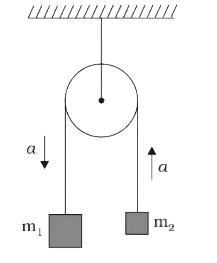A body of mass m1 collides elastically with a stationary body of mass m2 and returns along the same line with one fourth of its initial speed, then m1/m2=
1
2
0.66
0.33
The correct Answer is:C
To solve the problem, we will follow these steps:
Step 1: Understand the scenario
We have two bodies:
- Mass m1 is moving with an initial velocity v.
- Mass m2 is stationary (initial velocity = 0).
After the elastic collision, mass m1 returns with a velocity of −v4 (negative because it is in the opposite direction).
Step 2: Apply the conservation of momentum
The law of conservation of momentum states that the total momentum before the collision is equal to the total momentum after the collision.
Before the collision:
- Momentum of m1=m1⋅v
- Momentum of m2=m2⋅0=0
Total initial momentum:
pinitial=m1⋅v+0=m1v
After the collision:
- Momentum of m1=m1⋅(−v4)
- Momentum of m2=m2⋅v2 (where v2 is the velocity of m2 after the collision)
Total final momentum:
pfinal=−m1⋅v4+m2⋅v2
Setting the initial momentum equal to the final momentum:
m1v=−m1⋅v4+m2⋅v2(1)
Step 3: Apply the conservation of kinetic energy
Since the collision is elastic, the total kinetic energy before the collision is equal to the total kinetic energy after the collision.
Before the collision:
KEinitial=12m1v2+0=12m1v2
After the collision:
KEfinal=12m1(−v4)2+12m2v22
=12m1⋅v216+12m2v22
Setting the initial kinetic energy equal to the final kinetic energy:
12m1v2=12m1⋅v216+12m2v22(2)
Step 4: Solve the equations
From equation (1):
m1v+m1⋅v4=m2v2
m1(v+v4)=m2v2
m1⋅5v4=m2v2(3)
From equation (2):
m1v2=m1⋅v216+m2v22
m1v2−m1⋅v216=m2v22
m1(v2−v216)=m2v22
m1⋅15v216=m2v22(4)
Step 5: Substitute v2 from equation (3) into equation (4)
From equation (3):
v2=5m1v4m2
Substituting v2 into equation (4):
m1⋅15v216=m2(5m1v4m2)2
m1⋅15v216=m2⋅25m21v216m22
m1⋅15=25m21m2
Step 6: Solve for m1m2
Rearranging gives:
15m2=25m1
m1m2=1525=35
Final Answer
Thus, the ratio m1m2 is 35.
---
We have two bodies:
- Mass m1 is moving with an initial velocity v.
- Mass m2 is stationary (initial velocity = 0).
The law of conservation of momentum states that the total momentum before the collision is equal to the total momentum after the collision.
- Momentum of m1=m1⋅v
- Momentum of m2=m2⋅0=0
pinitial=m1⋅v+0=m1v
- Momentum of m1=m1⋅(−v4)
- Momentum of m2=m2⋅v2 (where v2 is the velocity of m2 after the collision)
pfinal=−m1⋅v4+m2⋅v2
m1v=−m1⋅v4+m2⋅v2(1)
Since the collision is elastic, the total kinetic energy before the collision is equal to the total kinetic energy after the collision.
KEinitial=12m1v2+0=12m1v2
KEfinal=12m1(−v4)2+12m2v22
=12m1⋅v216+12m2v22
12m1v2=12m1⋅v216+12m2v22(2)
From equation (1):
m1v+m1⋅v4=m2v2
m1(v+v4)=m2v2
m1⋅5v4=m2v2(3)
m1v2=m1⋅v216+m2v22
m1v2−m1⋅v216=m2v22
m1(v2−v216)=m2v22
m1⋅15v216=m2v22(4)
From equation (3):
v2=5m1v4m2
m1⋅15v216=m2(5m1v4m2)2
m1⋅15v216=m2⋅25m21v216m22
m1⋅15=25m21m2
Rearranging gives:
15m2=25m1
m1m2=1525=35
Thus, the ratio m1m2 is 35.
Topper's Solved these Questions
- BOOK - FIITJEECHAPTER - COLLISION EXERCISE - ASSIGNMENT PROBLEMS (OBJECTIVE) Level - I (ASSERTION REASONING TYPE)2videos
COLLISION
- BOOK - FIITJEECHAPTER - COLLISION EXERCISE - ASSIGNMENT PROBLEMS (OBJECTIVE) Level - II20videos
COLLISION
- BOOK - FIITJEECHAPTER - COLLISION EXERCISE - ASSIGNMENT PROBLEMS (SUBJECTIVE) Level - II17videos
COLLISION
- BOOK - FIITJEECHAPTER - AC CIRCUITSEXERCISE - ASSERTION REASONING TYPE1videos
AC CIRCUITS
- BOOK - FIITJEECHAPTER - CURRENT ELECTRICITYEXERCISE - Comprehension -43videos
CURRENT ELECTRICITY
Similar Questions
A body of mass m collides elastically with a stationary body of mass M. After collision, m has a speed equal to one-third of its initial speed. Calculate the ratio (m/M).
View SolutionA particle of mass m1 makes a head on elastic collision with another stationary body of mass m2, If m1 rebounds with half of its original speed then (m1m2) is
View Solution
Knowledge Check
- Question 1 - Select One or More
A ball of mass m1, collides elastically and head on with ball of mass m2 at rest. Then
AThe transfer of kinetic energy to the second ball is maximum when m1=m2BThe change of momentum of first ball is maximum, when m1<<m2.CThe velocity of the second ball is maximum, when m1>>m2.DNone of these - Question 2 - Select One
A body of mass M1 collides elastically with another mass M2 at rest. There is maximum transfer of energy when :
AM1>M2BM1<M2CM1=M2Dsame for all values of M1 and M2 - Question 3 - Select One
A body of mass m1 collides elastically with another body of mass m2 at rest. If the velocity of m1 after collision is 23 times its initial velocity, the ratio of their masses is :
A1:5B5:1C5:2D2:5
Two bodies of masses m1andm2(<m1) are connected to the ends of a massless cord and allowed to move as shown in figure. The pulley is both massless and frictionless. The acceleration of the centre of mass is (m1−m2)n(m1+m2)2g. Find the value of n.
 View Solution
View SolutionA ball of mass M collides elastically with another stationary ball of mass m. If M>m, find the maximum angle of deflection of M.
View SolutionA particle of mass m1, makes a head on elastic collision with another stationary body of mass m2 If m1, rebounds with half of its original speed then (m1m2) is
View SolutionA body of mass m kg collides elastically with another body at rest and then continues to move in the original direction with one half of its original speed. What is the mass of the target body ?
View SolutionA body of mass M moves with velocity v and collides elasticity with another body of mass m(M>>m) at rest , then the velocity of the body of mass m is
View Solution

